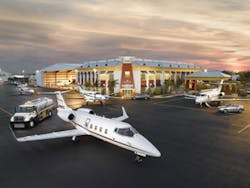Introducing ‘The New Banyan’
FT. LAUDERDALE — In 1979, Don Campion and partner John Price began a small aircraft sales and maintenance facility, Banyan Air Service, as a subtenant in a 4,000-square foot hangar. Since that time, Campion has progressively grown the Banyan Air footprint at Ft. Lauderdale Executive Airport (FXE) here while moving the company’s focus away from piston maintenance and into turbines, avionics, and line services. Central to that growth has been a unique partnership that Banyan has had with master lessor Sheltair Aviation Facilities, a company that also operates fixed base operations in Florida. Despite Banyan’s dramatic growth, a shortcoming has historically been limited ramp and terminal facilities. No more — in early March, Banyan will host its official grand opening of a $5.5 million terminal/hangar complex that not only changes the customer experience, but brings the FBO’s visibility on the airfield front and center.
The company actually moved into its new Ft. Lauderdale Executive position in late November, and its industry debut was expected to come with the Super Bowl, held in early February in Miami. Notably, says Campion, fractional provider NetJets selected the new Banyan FBO as its Super Bowl headquarters. As many as 100 corporate aircraft were expected to access Banyan for the event.
With the new terminal complex, Banyan Air Service now manages some 80 acres and 200,000 square feet of aviation facilities, according to Campion. Annual revenues of some $40 million are today equally divided between technical and FBO/line services, he explains. Included in the technical services side are turbine maintenance, avionics, and aircraft sales. The new complex is under a rewritten 30-year lease, which runs concurrent with the Sheltair master leasehold.
Comments Campion, “Within our own team here we’re calling 2007 the year of the new Banyan. There isn’t one area of Banyan that over the past 12 months has not gotten a complete facelift.”
The New FBO
Banyan will occupy the 14,500-square foot terminal’s main floor, departing a 3,200-square foot terminal which had significantly hampered its day to day operations through the years, as well as the customer experience. The limited ramp — once sandwiched into a corner of FXE — will more than triple in size in front of the terminal building, along with additional ramp on each side.
Comments Campion, “For years, our customers remained loyal to us as we continued to grow, in spite of having a facility that clearly could not handle the airplanes because of ramp size and facility size. We would have to continually move people’s aircraft to a temporary spot, which can be tough to do since most crews want their aircraft left alone. When we would have to move an airplane, we would actually have to tow onto an active taxiway, into another parking area, causing many more movements and transmissions with the tower.
“Now, not only do we have triple the space right out front, but on both ends of the terminal we can stack planes for a quarter mile.”
Campion says that many advised him that he may be overbuilding with the new terminal complex; in retrospect, he says, it doesn’t seem to be the case.
“We built the terminal about 25 percent bigger than what we really thought we needed,” he explains. “It was somewhat of a risk, but with all these customers who have been so loyal I almost felt like I wanted to reward them by making a large, comfortable ramp, lobby, and pilot lounges. After being here six weeks, I’m convinced it was the right plan. We often have 30 people in the lobby now; before, with eight it was full.”
The new terminal is actually several years behind the original schedule, says Campion. When he and Sheltair approached the airport about restructuring the lease to 30 years because of the investment, the city decided it first needed to come up with some benchmarks that tied lease length to investment.
Campion credits airport manager Clara Bennett, a winner of the NATA Airport Executive Partnership Award, with changing the business climate of the airport.
“Executive airport at one time was a place to get the cheapest gas,” he says. “It was a gas stop airport in the mid-80s. With customer expectations rising as business aviation grew, Banyan and the airport drifted away from the idea of having the cheapest gas to investing in what the professional pilots and their passengers needed — first class fuel trucks; well-trained people; the front desk staffed and knowledgeable.”
In the ‘90s, Bennett and her staff conducted an analysis as a result of the Banyan proposal and because a series of other leaseholds getting below the 15-year threshold, explains Campion. “There was a lot of energy and debate put into what formulas they would use. We were way over the limits that they finally agreed upon.”
The Sheltair Relationship
Through the years, one of the keys to Banyan’s growth and success, according to Campion, was the relationship with Sheltair. The company has three divisions — Sheltair Aviation Services, which operates FBOs in Florida and is expanding in the Northeast; Sheltair Aviation Facilities; and Holland Builders, Inc., which offers build-to-suit services — evidenced by the new Banyan complex.
Sheltair Aviation Facilities is the master leaseholder for much of the property at FXE, and controls properties at another eleven Florida airports. The unique arrangement for Banyan is one in which the FBO helps find customers to base in the hangars on its 80-acre footprint and then reaps the benefit of providing line and technical services. The customer writes the check to Sheltair for the space, and to Banyan for the services. Banyan is also responsible for finding tenants for the upper floor of the new FBO, which is nearly full.
Says Campion, “We’re running the complex as it relates to aviation activities. We work together with Sheltair as the property manager to try and get strategic tenants that contribute to the complex.”
